Front entries are the gateway to your home and set the tone for the interior. They’re not just functional elements but also key components of your home’s curb appeal and aesthetic. A well-designed front entry can make a lasting impression on visitors and passersby. Here, we’ll explore front entry styles, from classic to contemporary, and how architectural elements can enhance your home’s facade.
Entryway With Arched Shutters
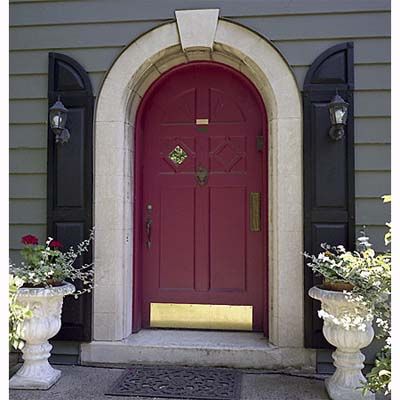
This arched doorway features symmetry and elegance, with twin sconces, urns, and half-moon shutters that create a balanced composition. The clever addition of a glazed panel in the six-panel door serves as a discreet peephole.
The limestone voussoirs—wedge-shaped stones forming the arch—are anchored by a prominent keystone, adding depth and architectural interest to the portal. This classic design is counterbalanced by the vibrant red door, which adds a pop of color and warmth, and the arched shutters.
Tudor Arch Entryway
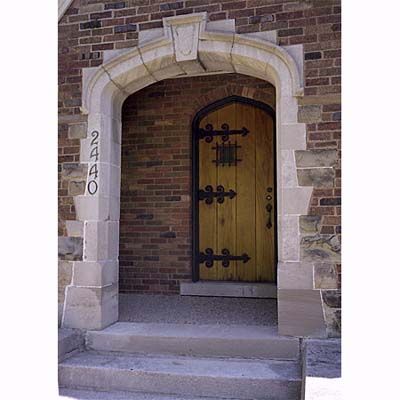
Tudor-style architecture is known for its distinctive pointed arches, and this entryway is a prime example. The masonry doorway is framed by alternating smooth and roughly cut quoins, topped by a hood mold that adds visual interest and protection from the elements. The wood-panel door, adorned with wrought-iron scrolled strap hinges, is nestled within the entryway and echoes the pointed arch above.
This style of entry is a good choice for homes with a medieval or English cottage aesthetic. The combination of stone and ironwork creates a sense of strength, while the arched shape adds a touch of romance. Tudor arches are a classic, marrying tradition with beauty effortlessly.
Entryway With an Elliptical Fanlight
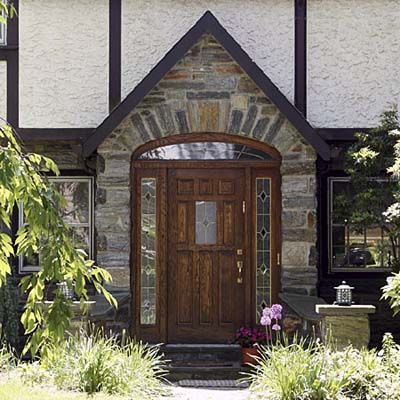
Fanlights are a hallmark of Georgian and Federal-style architecture, and this elliptical fanlight is a stunning example. The leaded sidelights, window, and fanlight work together to brighten an otherwise dark wooden door. The broad arch of the doorframe provides an interesting contrast to the steeply gabled entrance and vertical lines of the Tudor Revival house’s half-timbering.
This combination of architectural elements demonstrates how different styles can be blended harmoniously. The elegance of the fanlight softens the more austere Tudor elements. Fanlights capture natural light, enhancing the warmth and ambiance and making the entryway more welcoming.
Cottage Dutch Door Entryway

Dutch doors feature a split design that allows the top half to open independently of the bottom. They’re perfect for cottage-style homes. This tongue-and-groove Dutch door, painted in a soothing shade of blue, complements the stone cottage beautifully. The vine-like scrolled strap hinges add a decorative touch that enhances the rustic charm of the entry.
Dutch doors offer practical benefits as well as aesthetic appeal. They allow for ventilation while keeping pets and small children safely inside, and they create a welcoming, neighborly feel that’s perfect for cottage living. Their versatility and ability to adapt to various functional needs make them ideal for modern families.
Entryway with Ornate Ironwork

This enclosed pentagon-shaped portico makes for a dramatic and formal entry. The ornate iron balustrade and security gate add a layer of sophistication and protection. The arched windows echo the wheel window in the gabled facade, creating a cohesive architectural statement.
Ironwork can be both functional and decorative, offering security while also enhancing the overall design of the entryway. When choosing ornate ironwork, ensure it complements the style of your home and doesn’t overwhelm the other elements of the facade. Iron elements offer protection with a touch of grandeur.
Gothic Gable Entryway
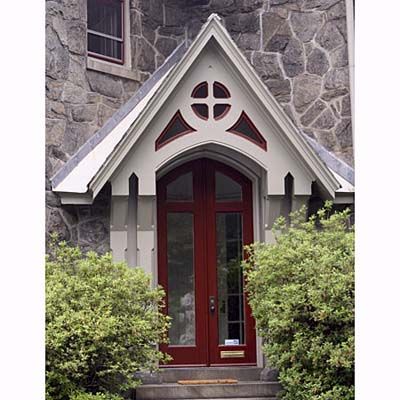
This Gothic-style gable is set into a corner of a stone house. The red trim highlights how the collar board and Celtic-cross cut-out mirror the silhouette of the door’s top lights. Gothic elements like pointed arches and decorative tracery add verticality and drama to the entryway.
The use of contrasting colors—in this case, the red trim against the stone—can help emphasize architectural details and draw the eye to the entry. This technique is effective in highlighting unique features like this Gothic gable.
Mission Style Entryway
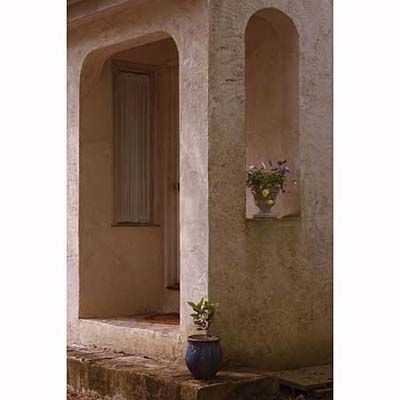
Mission-style architecture is characterized by simplicity and functionality, as shown by this entryway with its unadorned archways. The clean lines and lack of ornamentation create a sense of calm and order, reflecting the style’s origins in Spanish colonial missions.
This type of entry is well-suited to homes with a Southwestern or Mediterranean influence. The simplicity of the design highlights the quality of materials and craftsmanship. The smooth curves of the arches provide visual interest without excessive decoration. Mission-style entries embrace an austere yet inviting simplicity, perfect for those seeking understated elegance.
Recessed Arch Entryway
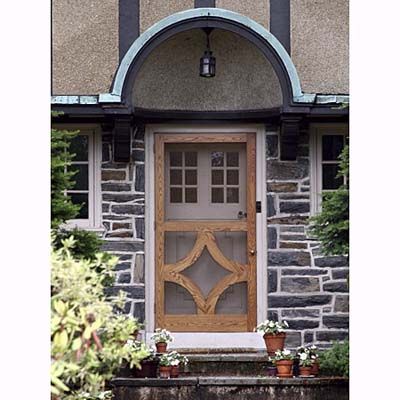
In this design, a wooden screen door becomes the focal point of a masonry house’s front entry. The clean lines of the door contrast beautifully with the facade of random-coursed stone and stucco. The quatrefoil on the screen door’s bottom panel complements the house’s half-timbering look.
Recessed arches add depth to an entryway, creating a sense of shelter and transition between the exterior and interior of the home. They also provide an opportunity to showcase decorative elements like this screen door, which adds both functionality and style to the entry.
Entryway with Mediterranean Surround Style
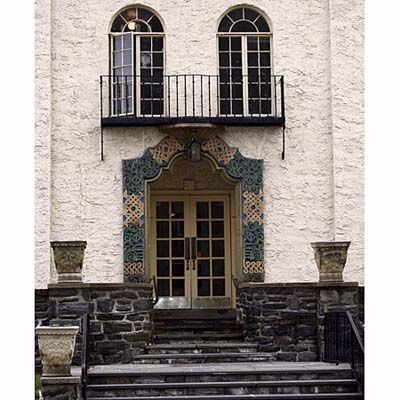
This entryway exudes Mediterranean charm with its intricately woven terra cotta panels framing the pointed arch. The five-light double doors are echoed in the twin balcony doors above, creating a sense of vertical rhythm that complements the curves in the tiled arch.
Mediterranean-style entries often feature rich textures and warm colors, as seen in the terra cotta tiles and wooden doors. These elements create a welcoming atmosphere that’s perfect for homes in sunny climates or those seeking to evoke the feel of a Mediterranean villa. The style’s association with relaxation and leisure lends itself well to creating comforting and inviting entryways.
Entryway Bedecked With Roses
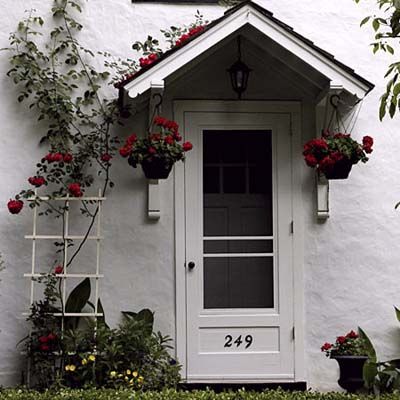
Some of the most charming entryways combine architectural elements with natural beauty. This bracketed gable overhang provides the perfect place to hang plants, while a simple trellis with climbing roses adds color and interest to an otherwise plain door.
Incorporating plants into your entryway design can soften hard architectural lines and create a more inviting approach to your home. Climbing plants like roses draw the eye upward and add vertical interest to the facade. The fusion of architecture and greenery offers a refreshing contrast to monotone urban settings.
Georgian Elegance Entryway
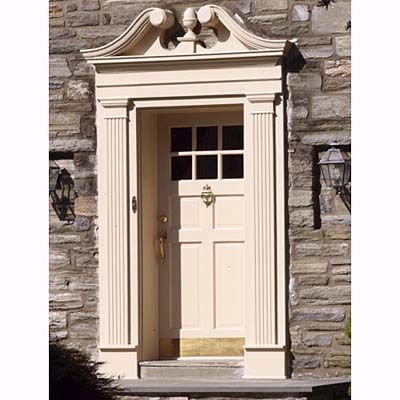
Georgian architecture is known for its symmetry and proportion, as shown by this elegant entryway. The broken pediment—also known as a swan’s neck—and fluted pilasters create a grand frame for the door. The four-panel door, with its six-light window, is understated by comparison, allowing the surround to take center stage.
This style of entry conveys formality and classical beauty. The balanced design and careful attention to detail are hallmarks of Georgian architecture. Georgian entries offer an air of timeless sophistication and prestige, making them ideal for those who want to convey history and elegance.
Entryway with a Bay Window
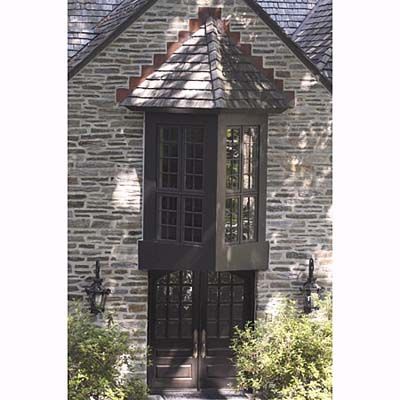
This unusual two-sided bay window plays off the triangular shape of the steeply arched gable, creating a unique and eye-catching entryway. The casement windows, with their many rectangular lights, echo the design of the double wooden doors below. Twin sconces and symmetrically placed bushes add to the overall balance of the composition.
Bay windows near the entry can provide extra interior space and allow more natural light into the home. When incorporated into the entryway design, they can create a striking architectural feature that sets your home apart from others on the street.
Iron-Clad Entryway
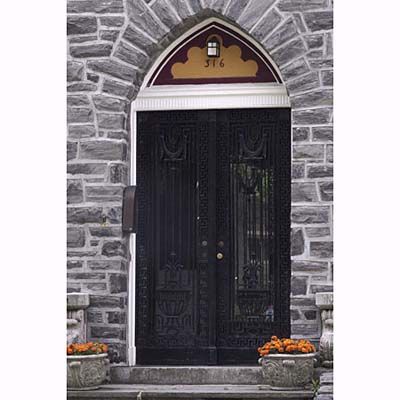
Security doesn’t have to come at the expense of style, as demonstrated by this wrought-iron gate. With a potted urn pattern and a Greek key border, the gate enhances the entry and protects the double doors with glass panels. Above the lintel, a tympanum set within a pointed arch contains the house number and a light fixture for functionality and decorative interest.
When choosing a design, consider patterns that complement your home’s architectural style and other decorative elements. Iron-clad entries seamlessly blend safety with artistry.
Entryway with a Medieval Balconet
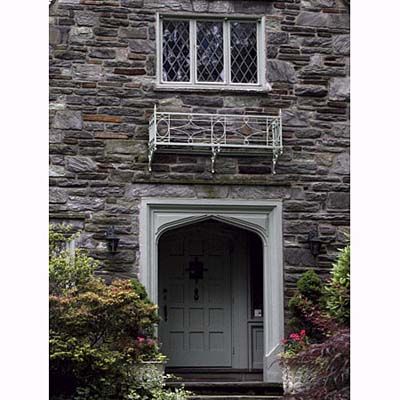
This entryway combines elements from different architectural periods to create a unique and visually interesting facade. A Tudor arch frames a recessed panel front door, both painted the same neutral shade of green to unify the design. The arch points toward a quatrefoil pattern wrought-iron balconet, also painted green, that serves a purely decorative purpose.
This combination of medieval-inspired elements with Victorian-era decorative ironwork demonstrates how different architectural styles can blend together. The consistent use of color creates a cohesive look. This design celebrates historical charm while allowing for modern creativity.
Spanish Colonial Revival Entryway
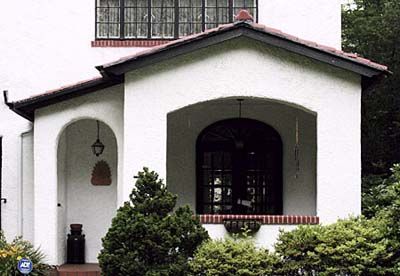
Spanish Colonial Revival architecture is characterized by white stucco walls, red tile roofs, and arched openings, all of which are present in this entryway. The arched doorway leads to a covered porch, which features another arched opening through which you can see arched wooden glazed double doors.
The simplicity of the white stucco is accented by the red-tiled roof, window sill, and steps. This style of entry creates a sense of depth and transition, with the covered porch serving as an intermediate space between the exterior and interior of the home.
Entryway with Paint and Decoration
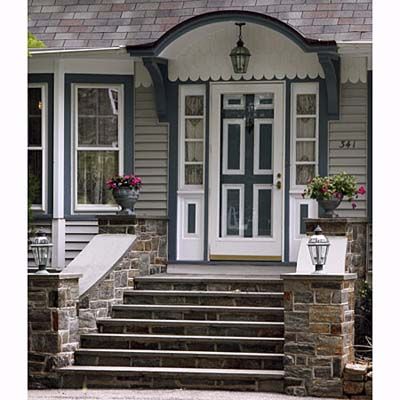
This entryway demonstrates how paint and decorative elements can be used to unify diverse architectural features. The bracketed arched overhang and shingles are Italianate in style, while the raised panel door with recessed molding and oversized sidelights are more typical of Colonial Revival architecture.
These elements tie together beautifully, thanks in part to the bold use of forest green accent paint on the trim. This use of color highlights the architectural details and creates a cohesive look that enhances the overall curb appeal of the home.
A Study in Simplicity
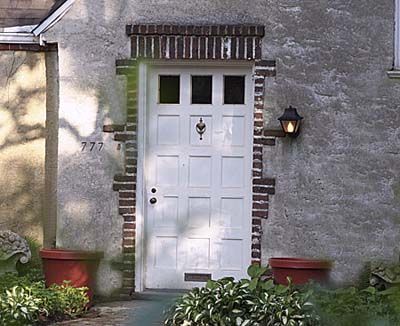
Sometimes, less is more when it comes to entryway design. This simple recessed-panel door with three lights across the top is framed by simple brickwork. Vertically placed stretchers form a lintel on top, while the irregularly coursed headers and stretchers along the sides serve as symmetrical “drapes.”
The understated house number and light fixture contribute to the minimalist aesthetic. This type of entry proves that a front door doesn’t need to be elaborate to be effective—sometimes, clean lines and quality materials are all that are needed to create a welcoming entrance.
